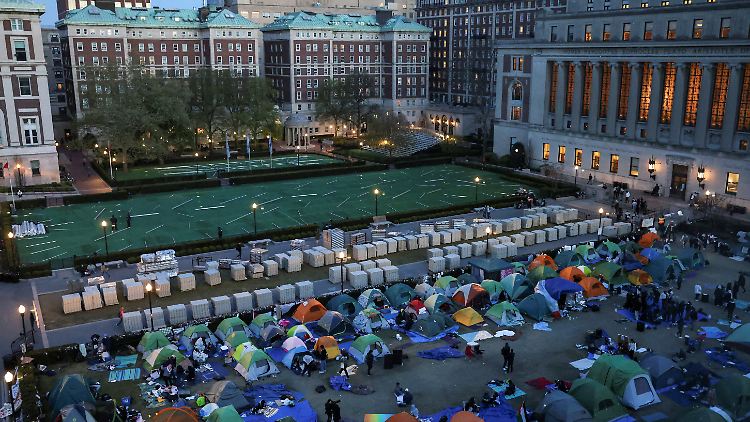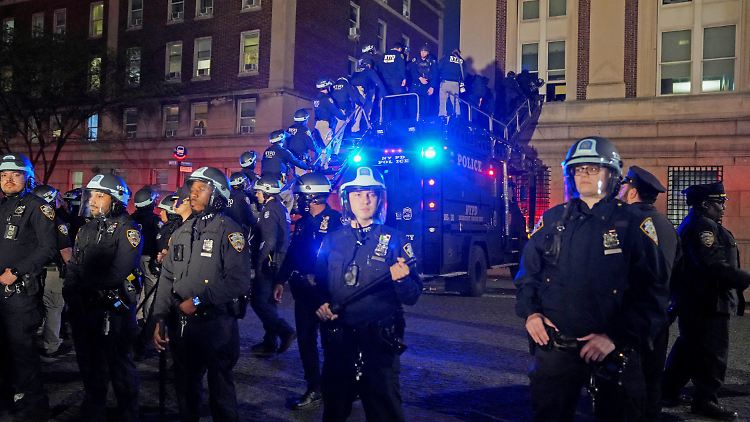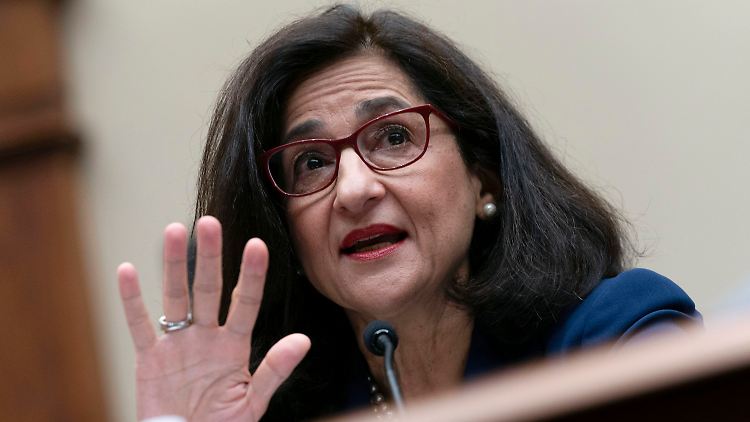In the USA, from East to West, university administrations and the police have cracked down on pro-Palestinian protests. The security forces arrested students, dismantled camps and ended occupations. But that is only part of the story.
In recent weeks, protests against the war in the Middle East have escalated into violence at US universities. The police moved out, took increasingly rigorous action against demonstrators, ended occupations and broke up camps. Nationwide, it has arrested at least 2,300 people at more than 40 universities in the past four weeks. These are mostly pro-Palestinian protests against the Israel-Hamas war, but also pro-Israel demonstrations taking place on university campuses.
The tents, barricades and arrests are examples of a social conflict that revolves around the question of what is allowed to happen at universities. How can debates take place on a campus and who decides about them? Should politicians get involved or stay out? Since the war in the Middle East began in October, there has been a power struggle between students and university administrations over these issues at universities in the USA.
The intra-academic tensions were dragged onto the big national stage in December. The Republican-controlled Education Committee of the House of Representatives questioned the presidents of four private elite universities almost inquisitorially: What is the university doing about the protests and anti-Semitism? At the televised hearings in Washington, the presidents of Harvard and Pennsylvania University cut a bad figure and were subsequently forced to resign. At least two billionaires and major donors had flexed their muscles behind the scenes, writes the New York Times.
Pawn sacrifice in Congress
Nemat Shafik, president of Columbia University in New York City, was also summoned, but delayed her appearance until April 17. She had received advice and training before turning herself in. At this point, there had already been internal discussions for months about the statements and publications of several well-known professors at the university: had they made anti-Semitic statements or did they remain within the scope of academic freedom?
In Congress, representatives peppered Shafik with questions about the professors. She defended herself by saying that several of the professors had already been banned from the classrooms. Then things got strange: In front of the cameras, the president assured that a certain lecturer would “never teach at Columbia again” because of pro-Hamas statements. It smelled like a pawn sacrifice with which Shafik wanted to save her own head. Academic freedom was never mentioned at the hearing.
Meanwhile, in New York, pro-Palestinian demonstrators set up tents on Columbia’s campus lawn and made their presence felt with signs, megaphones and slogans: They demanded that the university’s money be withdrawn from Israel. The protest was peaceful and largely adhered to the usual rule that it should not restrict university operations.
The day after her hearing, Shafik called the police to campus, who marched in riot gear and arrested over 100 people. The university administration suspended the students and kicked them out of their living quarters. She obviously wanted to set an example. However, the attempt to nip the demonstrations in Manhattan in the bud caused the complete opposite. Students and activists across the country showed solidarity. Camps have now sprung up at dozens of other universities.
“That was the tipping point”
The protests have escalated since then. In many places, demonstrators are insisting on their demands for divestment, i.e. the withdrawal of investments from Israel. Some teachers join in. Negotiations usually come to nothing. Instead, universities asked the police to break up camps. The largest violent confrontation to date took place at the public University of California. Pro-Palestinian and pro-Israel demonstrators fought for hours last week using improvised armor, explosive weapons and fireworks. It was only after several hours that the police intervened.


The tent camp on the Columbia University campus in Manhattan before the final evacuation.
(Photo: REUTERS)
“The first arrests made everyone angry,” says a Columbia University employee who didn’t want his name published for fear of disciplinary action. “That was the tipping point. Why are they messing with our students?” Like them, the university staff did not have a common position on Israel and Palestine. But now they are united: in rejecting the measures taken by the university management. According to the employee, it’s about principle. “So are academic debates now being decided by the police?” he asks, frustrated.
It is “heartbreaking” to see how this previously safe place and its values are treated. “Free research, being able to say things under your own name without fear. Shafik broke this agreement.” The campus must be treated like a large classroom where it can be loud and provocative. “Nobody sends the police in there because there’s a discussion going on.” But the management is not interested in education, but in the numbers and the rankings in which the university should be at the top.
Elite universities and investors
Harvard, Pennsylvania, Columbia – these are three of the eight so-called Ivy League universities in the USA; elite private universities in the northeast of the country, which collectively manage at least $183 billion in assets. Together, the universities have 140,000 students and 23,500 academic employees. All depend on the goodwill of large donors. At the same time, universities charge high tuition fees.
At many universities, the decisions of private university management are opaque. At Columbia, a board of trustees sits at the controls, which largely appoints itself, controls the president and determines the university’s vast assets. Last year, the Columbia Investment Management Company said it managed $18.7 billion; 774 million of the 5.9 billion dollars in annual expenditure were profits from the investment sector. The university is also one of the largest property owners in New York City.
Israel supporters argue that the pro-Palestinian students’ demand for divestment has an anti-Semitic basis: After all, Israel is not the only country in the world that violates human rights – but it is the only Jewish one. So why should universities withdraw their money there? Divestment is also a core demand of the controversial BDS movement.


The New York police climbed in through the window and cleared the occupied building on the Columbia University campus.
(Photo: REUTERS)
After the first show of force, the situation in Manhattan did not calm down, on the contrary. Protests took place almost daily in front of the gates of Columbia in solidarity with the students on campus. When demonstrators occupied a building, the university management only allowed essential employees and its own students onto the premises. Negotiations between management and protesters came to nothing. At some point the police arrived again, ended the occupation by force and arrested more than 100 people again. Afterwards she also completely broke up the tent camp.
Hardness from the start
At nearby New York University, another important private university in the city, the police also cracked down on several occasions, arresting activists and clearing a protest camp. In one of the university buildings in southern Manhattan, a few students are sitting on the fifth floor reading; Sparkling glass doors and bright colors radiate calm. One of the office doors is plastered with notes and posters about freedom of expression. Behind it, Robert Cohen, professor of history and social movements, sits at his desk, closely surrounded by overflowing shelves and stacked books.
“Student movements have always been unpopular in the US,” he explains. However, the police operation at Columbia that triggered it shows authoritarian tendencies: “This is a very heated reaction, even though the student protests are very moderate compared to the 1960s.” In 1968, for example, five buildings were occupied before the police arrived. Among other things, Cohen researches the protests against the Vietnam War at the time. They built up frustration over US involvement for many years before the violence reached its peak in 1970. The police shot several students.
It is common practice these days to only break up protests and expel participants if it massively disrupts university operations or violates rules and laws, says Cohen. But the current protests are more comparable to the peaceful beginnings around 60 years ago. When politicians today call for a tough hand against students, Cohen said, it is in this tradition of cultural conservatism, with the motto: “Shut up and learn.” This led to the current movement.
Professor: Lack of student participation as a problem
Cohen remembers a martial quote from the later US President Ronald Reagan, who wanted to end the anti-war protests in California at the time: “If it takes a bloodbath, let’s get it over with,” he said. “No more appeasement politics.” The current problem at many US universities is the lack of student participation, says the professor. “When there is no opportunity to vote, you go out into the streets to be heard.” Escalation is the result. “This is due to the university’s elitism.”
The professor considers the tendency to romanticize Palestinian interests to be problematic, as well as masked demonstrators breaking windows and setting up barricades, which makes it almost impossible for them to receive broad social support. On the other hand, Cohen is concerned about the authoritarian tendencies he sees as a result of Donald Trump’s presidency. For months, conservative media have been portraying the demonstrators as a “woke” threat, as out-of-control anti-Semitic protests by leftists and Democrats that only toughness can help. However, the student movement, which according to Cohen is the largest in the 21st century, has achieved one thing: people are talking more critically about the war between Israel and Hamas.
A few universities have reached an agreement with the demonstrators. At Brown University, another Ivy League university, students are now supposed to submit arguments for divestment, which the board will then decide on in October. It is unclear where the university has invested its money. Brown University has hired external asset managers and investors for 96 percent of its assets. Several major donors told the New York Times that they would reduce or stop their donations if the university gave in to the demands. So it would be surprising if the students were successful. They have stopped their protest.

